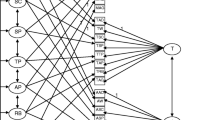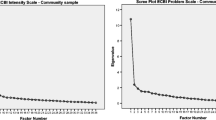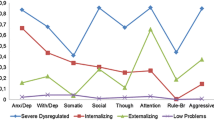Abstract
The correspondence between Diagnostic and Statistical Manual (3rd ed.) (DSM-III) diagnoses and statistically derived syndromes was examined within a community sample of children and adolescents in Puerto Rico. Specifically, the extent to which behavior dimensions, derived from the Child Behavior Checklist and the Youth Self-Report, corresponded to psychiatric diagnoses, derived from parent and child versions of the Diagnostic Interview Schedule for Children, was examined. The alternative approaches for assessing psychopathology in children and adolescents were compared against external validators. The results indicated a meaningful convergence between DSM-III diagnoses and statistical syndromes; however, a one-to-one correspondence did not emerge. Little evidence was found for “diagnostic thresholds.” There was no evidence of the superiority of either the statistically derived syndromes or the DSM-III diagnoses. The incorporation of a measure of impairment improved the validity of both approaches. Adding parental reports to the selfreports of adolescents yielded little gain in the validity of either the statistical or diagnostic approach. The implications for the definition and assessment of child and adolescent disorders are discussed.
Similar content being viewed by others
Reference
Achenbach, T. (1985).Assessment and taxonomy of child and adolescent psychopathology. Newbury Park, CA: Sage Publications.
Achenbach, T. (1990/1991). “Comorbidity” in child and adolescent psychiatry: Categorical and quantitative perspectives.Journal of Child and Adolescent Psychopharmacology, 1, 271–278.
Achenbach, T. M. (1991).Megrative guide for the 1991 CBCL/4-18, YSR and TRF Profiles. Burlington: University of Vermont, Department of Psychiatry.
Achenbach, T., & Edelbrock, C. (1978). The classification of child and psychopathology: A review and analysis of empirical efforts.Psychological Bulletin, 85, 275–1301.
Achenbach, T., & Edelbrock, C. (1983).Manual for the Child Behavior Checklist and Revised Child Behavior Profile. Burlington: University of Vermont.
Achenbach, T., & Edelbrock, C. (1986).Manual for the Youth Self-Report and Profile. Burlington: University of Vermont.
Achenbach, T. M., & Edelbrock, C. (1987).Manual for the Youth Self-Report and Profile. Burlington, VT: University of Vermont Department of Psychiatry.
Achenbach, T., Bird, H. R., Canino, G., Phares, V., Gould, M. S., & Rubio-Stipec, M. (1990). Epidemiological comparisons of Puerto Rican and U.S. Mainland children: Parent, teacher, and self-reports.Journal of the American Academy of Child and Adolescent Psychiatry, 29, 84–93.
American Psychiatric Association (1980).Diagnostic and Statistical Manual of Mental Disorders (third edition). Washington, DC: American Psychiatric Association.
American Psychiatric Association (1987).Diagnostic and Statistical Manual of Mental Disorders (third edition-revised). Washington, DC: American Psychiatric Association.
American Psychiatric Association (in preparation).Diagnostic and Statistical Manual of Mental Disorders (fourth edition). Washington, DC: American Psychiatric Association.
Berkson, J. (1946). Limitations of the application of fourfold table analysis to hospital data.Biometrics Bulletin (nowBiometrics), 2, 47–53.
Bird, H. R., Canino, G., Rubio-Stipec, M., Gould, M. S., Ribera, J., Sesman, M., Woodbury, M., Huertas-Goldman, S., Pagan, A., Sanchez-Lacay, A., & Moscoso, M. (1988). Estimates of the prevalence of childhood maladjustment in a community survey in Puerto Rico.Archives of General Psychiatry, 45, 1120–1126.
Bird, H., Canino, G., Rubio-Stipec, M., & Ribera, J. (1987). Further measures of the psychometric properties of the Children's Global Assessment Scale (CGAS).Archives of General Psychiatry, 44, 821–824.
Bird, H. R., Gould, M. S., & Staghezza, B. (1992). Aggregating data from multiple informants in child psychiatry epidemiological research.Journal of the American Academy of Child and Adolescent Psychiatry, 31, 78–85.
Bird, H. R., Gould, M. S., Rubio-Stipec, M. Staghezza, B., & Canino, G. (1991). Screening for childhood psychopathology in the community using the Child Behavior Checklist.Journal of the American Academy of Child and Adolescent Psychiatry, 30, 116–123.
Bird, H. R., Yager, T. J., Staghezza, B., Gould, M. S., Canino, G., & Rubio-Stipec, M. (1990). Impairment in the epidemiological measurement of childhood psychopathology in the community.Journal of the American Academy of Child and Adolescent Psychiatry, 29, 796–803.
Brislin, R. W., Lonner, W., & Thorndike, R. (1973).Cross-cultural research methods. New York: Wiley.
Canino, G. J., Bird, H. R., Rubio-Stipec, M., Woodbury, M. A., Ribera, J. C. Huertas, S. E., & Sesman, M. J. (1987). Reliability of child diagnosis in a Hispanic sample.Journal of the American Academy of Child and Adolescent Psychiatry, 26, 560–565.
Cantwell, D. P., & Baker, L. (1988). Issues in the classification of child and adolescent psychopathology.Journal of the American Academy of Child & Adolescent Psychiatry, 27, 521–533.
Coddington, R. D. (1972). The significance of life events as etiologic factors in the diseases of children. II. A study of a normal population.Journal of Psychosomatic Research, 16, 205–213.
Costello, A. J., Edelbrock, C. S., Kalas, R., Kessler, M. K., & Klaric, S. A. (1982).NIMH Diagnostic Interview Schedule for Children, Bethesda, MD; National Institute of Mental Health.
Edelbrock, C., & Achenbach, T. M. (1980). A typology of Child Behavior Profile patterns: Distribution and correlates in disturbed children aged 6 to 16.Journal of Abnormal Child Psychology, 8, 441–470.
Edelbrock, C., & Costello, A. J. (1988). Convergence between statistically derived behavior problem syndromes and child psychiatric diagnoses.Journal of Abnormal Child Psychology, 16, 219–231.
Endicott, J., Spitzer, R., Fleiss, J., & Cohen, J. (1976). The global assessment scale: A procedure for measuring overall severity of psychiatric disturbance.Archives of General Psychiatry, 33, 766–771.
Gould, M. S., & Shaffer, D. (1985). Epidemiology and child psychiatry. In J. Cavenar (Ed.),Psychiatry. New York: Lippincott.
Kish, L. (1965).Survey sampling. New York: Wiley.
Rutter, M., & Shaffer, D. (1980). DSM-III. A step forward or back in terms of the classification of child psychiatric disorders.Journal of the American Academy of Child Psychiatry, 19, 371–394.
Shaffer, D., & Bettes, B. (1991). Concepts of diagnostic classification in child psychiatry. In J. Wiener (Ed.),Textbook of Child and Adolescent Psychiatry. Washington, DC: American Psychiatric Press.
Shaffer, D., Campbell, M., Cantwell, D., Bradley, S., Carlson, G., Cohen, D., Denckla, M., Frances, A., Garfinkel, B., Klein, R., Pincus, H., Spitzer, R. L., Volkmar, F., & Widiger, T. (1989). Child and adolescent psychiatric disorders in DSM-IV: Issues facing the work group.Journal of the American Academy of Child and Adolescent Psychiatry, 25, 830–835.
Shaffer, D., Gould, M. S., Brasic, J., Ambrosini, P., Fisher, P., Bird, H. R., & Aluwahlia, S. (1983). A Children's Global Assessment Scale (CGAS).Archives of General Psychiatry, 40, 1228–1231.
Weinstein, S. R., Noam, G. G., Grimes, K., Stone, K., & Schwab-Stone, M. (1990). Convergence of DSM-III diagnoses and self-reported symptoms in child and adolescent inpatients.Journal of the American Academy of Child and Adolescent Psychiatry, 29, 627–634.
World Health Organization (1978).Internal Classification of Diseases (ninth edition). Geneva: World Health Organization.
World Health Organization (in preparation).The ICD-10 classifcation of mental and behavioral disorders: Diagnostic criteria for research. Geneva: World Health Organization.
Author information
Authors and Affiliations
Additional information
This research was supported by grant MH 38821 from the National Institute of Mental Health.
The authors wish to acknowledge Glorisa Canino, Ph.D., and Maritza Rubio-Stipec, M.A., of the University of Puerto Rico, co-investigators in the epidemiologic project and to Barbara Bettes, Ph.D. for her contribution to preliminary analyses for this manuscripl. Portions of this paper were presented at the 38th Annual Meeting of the American Academy of Child and Adolescent Psychiatry, San Francisco, October 1991.
Rights and permissions
About this article
Cite this article
Gould, M.S., Bird, H. & Jaramillo, B.S. Correspondence between statistically derived behavior problem syndromes and child psychiatric diagnoses in a community sample. J Abnorm Child Psychol 21, 287–313 (1993). https://doi.org/10.1007/BF00917536
Revised:
Issue Date:
DOI: https://doi.org/10.1007/BF00917536




